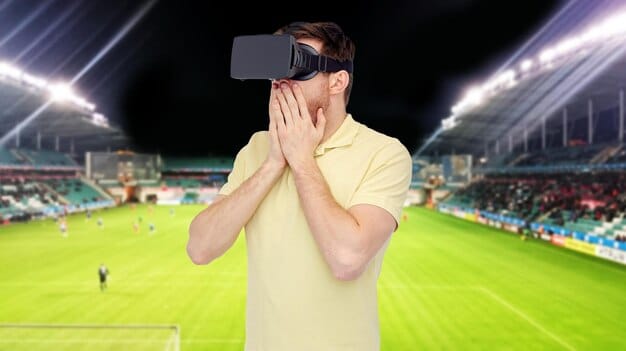Augmented Reality in Soccer: Enhancing the US Viewing Experience

Augmented reality is revolutionizing how US audiences experience soccer broadcasting, transforming traditional viewership into an immersive, data-rich, and interactive encounter that brings fans closer to the action and deeper into the game’s strategic nuances.
The landscape of sports broadcasting is undergoing a profound transformation, and soccer, in particular, is at the forefront of this revolution. One of the most compelling innovations making waves in the United States is the integration of augmented reality. The Future of Soccer Broadcasting: How Augmented Reality is Enhancing the US Viewing Experience is not merely a hypothetical scenario; it’s a rapidly evolving reality that promises to redefine how fans engage with the beautiful game.
The Dawn of Immersive Broadcasting
For decades, watching soccer has primarily been a passive experience, mediated by cameras and commentators. However, the advent of augmented reality (AR) is shattering these traditional boundaries, introducing a new era of immersive broadcasting. This technology overlays digital information onto the real world, seamlessly integrating statistics, analytical data, and interactive elements directly onto the live match footage.
The shift is from merely observing to actively participating in a richer narrative. Broadcasters are leveraging AR to provide real-time insights that were previously only available to professional analysts or dedicated statisticians. This depth of information enhances comprehension and appreciation for the game’s complexities, attracting a broader audience, including those new to soccer.
Unveiling Tactical Insights
One of the most impactful applications of AR in soccer broadcasting is its ability to visualize tactical movements and formations. Coaches spend countless hours analyzing strategies, and AR brings these intricate details directly to the viewer’s screen.
- 🏃♂️ Player movement tracking: Instantly see player runs, distances covered, and heatmaps.
- 🎯 Positional analysis: Understand team shapes in real-time, highlighting pressing lines and defensive blocks.
- 📉 Strategic overlays: Visualize offside lines, passing lanes, and shot trajectories with precision.
These visual aids demystify abstract concepts, giving fans a deeper understanding of tactical battles unfolding on the pitch. This level of insight was once exclusive to experts, but AR democratizes it, making complex strategic elements accessible and engaging for every viewer at home.
The beauty of this technology lies in its unobtrusive nature. Rather than distracting from the game, AR enhancements complement it, layering valuable information without obscuring the action. It’s about providing context and depth, enriching the viewing journey for both casual observers and seasoned aficionados. The goal is to elevate the overall experience, making every match feel like a masterclass in soccer analysis.
Interactive Fan Engagement and Personalization
Beyond enhancing analytical insights, augmented reality is poised to revolutionize fan engagement by introducing unprecedented levels of interactivity and personalization into soccer broadcasting. Viewers are no longer passive recipients; they become active participants, able to customize their viewing experience to suit individual preferences.
Imagine being able to select specific players whose real-time statistics you want constantly displayed, or activating an overlay that highlights only the passes completed by your favorite team. This level of personalization moves beyond one-size-fits-all broadcasting, catering directly to the unique interests of each fan.

Customizing Your Viewing Experience
The interactive elements enabled by AR are diverse and impactful. Broadcasters can offer multiple AR overlays, allowing fans to choose what information is relevant to them at any given moment. This could range from purely statistical data to humorous, fan-generated content.
- 📊 On-demand player stats: Access detailed performance metrics for any player with a simple click.
- 📺 Multi-angle viewing: Switch between camera angles with AR prompts, feeling closer to the action.
- 💬 Social media integration: See live fan reactions and polls integrated into the broadcast environment, creating a communal experience.
This evolving landscape suggests a future where watching a soccer match is less about a fixed broadcast and more about a customizable, on-demand, and highly interactive spectacle. This shift towards viewer autonomy is critical for attracting and retaining audiences in an increasingly competitive media market, especially in the US where sports consumption patterns are highly diversified. The power of choice fosters a deeper connection and loyalty among fans, making them feel truly invested in the broadcast itself.
The personalization aspect also extends to advertising and sponsorships. AR can create dynamic, context-aware advertisements that appear seamlessly within the broadcast, tailored to the viewer’s demographic or viewing habits without disrupting the flow of the game. This innovative approach offers new revenue streams for broadcasters while delivering more relevant content to viewers.
Technological Foundations and Implementation Challenges
The promise of enhanced soccer broadcasting through augmented reality rests on robust technological foundations, encompassing advanced camera systems, real-time data processing, and sophisticated rendering engines. However, like any nascent technology, its widespread implementation faces several challenges that require innovative solutions and significant investment.
At the core, highly precise tracking systems are essential. These often involve multiple camera arrays strategically placed around the stadium, capable of capturing every detail of player movement and ball trajectory. This raw data then feeds into powerful servers that process it in real-time, translating complex movements into understandable visual graphics.
Overcoming Technical Hurdles
The seamless integration of AR overlays into a live broadcast demands immense computational power and ultra-low latency. Any delay between the live action and the visual augmentation can disrupt the immersive experience. Broadcasters are continually working on optimizing these systems to ensure a fluid and instantaneous delivery.
- ⚙️ Data processing speed: Reducing latency is crucial for real-time overlays.
- 🌐 Interoperability: Ensuring different AR systems can communicate effectively.
- 📉 Scalability: Developing solutions that can be applied across various broadcast environments and budgets.
Another significant hurdle involves the rendering quality. The AR graphics must be visually appealing and seamlessly blend with the live footage to avoid appearing artificial or distracting. This requires highly skilled graphic designers and engineers who can create compelling visual elements that enhance, rather than detract from, the viewing experience.
Beyond the technical aspects, there’s also the challenge of widespread adoption. While top-tier leagues and broadcasters might have the resources to invest in cutting-edge AR technology, ensuring accessibility for smaller leagues and local broadcasts is equally important for the technology’s long-term success. This involves developing more affordable and scalable solutions that can be adapted to various production budgets. The industry is actively exploring cloud-based rendering and AI-driven processing to address these scalability issues and make AR more accessible to a broader range of content creators.
The Impact on US Soccer Growth and Fan Base
The United States has long been a fertile ground for soccer’s growth, with rising popularity of both domestic leagues like MLS and international competitions. Augmented reality broadcasting has a unique opportunity to accelerate this growth trajectory by making soccer more accessible, understandable, and engaging for a diverse American audience. It addresses some of the historical barriers to adoption by distilling complex tactical elements into easily digestible visual narratives.
By providing immediate visual cues and data points, AR can make the game less daunting for new fans who may not be familiar with its intricacies. This educational aspect is crucial in a market where soccer competes with well-established sports like American football, basketball, and baseball, each with their own deeply ingrained fan cultures and broadcasting traditions.

Attracting New Generations of Fans
Younger generations, fluent in digital interactions and accustomed to rich, engaging visual content, are particularly receptive to AR’s immersive capabilities. This demographic is a key target for the continued expansion of soccer in the US. AR broadcasts can resonate deeply with their expectations for interactive media.
- 🎮 Gamification elements: Integrating game-like features and challenges into the broadcast.
- 📱 Second-screen experiences: Enabling AR interactions through mobile devices alongside TV viewing.
- 🎁 Enhanced storytelling: Using AR to provide enriched historical context or player biographies during breaks.
Furthermore, AR can bridge the gap for casual viewers who might otherwise tune out during less action-packed moments. By overlaying interesting statistics, historical facts, or even fan-driven polls, AR keeps viewers engaged throughout the match, transforming potentially dull moments into opportunities for discovery and interaction. This continuous engagement is vital for converting casual viewers into dedicated fans, strengthening the overall soccer fan base in the US significantly. The aim is to make every minute of the broadcast compelling, irrespective of the scoreline or intensity of play, ensuring a superior entertainment value.
The increased visual appeal and interactive nature of AR-enhanced broadcasts also make soccer more marketable for advertisers and sponsors, potentially drawing more investment into the sport. This influx of capital can, in turn, be reinvested into player development, league infrastructure, and grassroots programs, creating a virtuous cycle of growth for US soccer.
Challenges and Ethical Considerations for Broadcasters
While the potential benefits of augmented reality in soccer broadcasting are immense, its adoption is not without challenges and ethical considerations. Broadcasters must navigate a complex landscape that includes maintaining editorial integrity, managing data privacy, and ensuring equitable access to these technologies.
One primary concern revolves around the potential for “information overload.” While AR offers a wealth of data, presenting too much information simultaneously can overwhelm viewers, detracting from the core experience of watching the game. Broadcasters need to find a delicate balance, providing valuable insights without turning the screen into a cluttered mess. This requires thoughtful design and intuitive user interfaces.
Navigating the Ethical Landscape
The use of advanced tracking and data analysis capabilities inherent in AR raises important questions about player data privacy and the potential for misuse of information. Ensuring transparency in data collection and establishing clear guidelines for its use are paramount.
- 🔒 Data privacy: Protecting player and fan data from unauthorized access or commercial exploitation.
- ⚖️ Editorial independence: Preventing commercial interests from unduly influencing AR content.
- 🌍 Accessibility equity: Ensuring that AR enhancements don’t create a two-tier viewing experience based on access to technology.
Another ethical consideration involves “deepfake” or manipulated realities. As AR technology becomes more sophisticated, the line between reality and digital overlay could blur. Broadcasters have a responsibility to maintain trust with their audience by clearly distinguishing between factual data overlays and purely imaginative or artistic visual enhancements. The public must be assured that what they are seeing is an honest representation of the game overlaid with accurate, verifiable information, not a distorted reality.
Furthermore, broadcasters must consider the cost of implementing and maintaining these advanced AR systems. The high initial investment could create a disparity between major networks and smaller outlets, potentially limiting the reach of cutting-edge AR experiences. Finding ways to democratize access to this technology, perhaps through shared infrastructure or cloud-based solutions, will be crucial for its widespread and equitable adoption across the broadcasting spectrum.
Looking Ahead: The Future Evolution of AR in Soccer
The journey of augmented reality in soccer broadcasting is just beginning. What we see today—real-time statistics, tactical overlays, and enhanced replays—is merely the tip of the iceberg. The future promises an even more seamless, personalized, and interactive viewing experience as the technology matures and innovators explore new frontiers.
One significant area of evolution will be the integration of AR with virtual reality (VR) and mixed reality (MR) technologies. Imagine putting on a VR headset and being transported onto the field, experiencing the game from a player’s perspective, with AR elements providing real-time data directly in your field of vision. This blending of realities could create truly holographic viewing experiences, blurring the lines between watching and participating.
Anticipated Advancements and Unexplored Possibilities
Future iterations of AR in soccer broadcasting will likely leverage artificial intelligence (AI) even more profoundly, enabling predictive analytics, personalized commentary, and adaptive content delivery based on individual viewer preferences and reactions.
- 🤖 AI-driven insights: Predicting player movements or outcomes based on historical data.
- 🗣️ Personalized commentary: Tailoring commentary style and content to individual viewer profiles.
- 🔄 Adaptive overlays: AR elements that automatically adjust based on game flow or viewer interest.
Another exciting prospect is the potential for AR to facilitate remote co-viewing experiences. Friends and family, even if physically separated, could ‘watch’ a game together in a shared virtual space, with AR elements enhancing their collective experience and interaction. This could redefine how social connections are forged around live sports.
The evolution will also see AR moving beyond traditional screen-based viewing to pervasive computing environments. This means AR content could be projected onto surfaces in your living room, or experienced through lightweight, fashionable smart glasses, making the technology feel less like an addition and more like an integral part of everyday life. The ultimate goal is to make the technology disappear, leaving only a profoundly enhanced and intuitive viewing experience, fully embedding future of soccer broadcasting into the fabric of daily life in the US.
Ultimately, the continuous innovation in AR will not only enhance the viewing experience but also create new forms of content, revenue streams, and interactive opportunities for fans, broadcasters, and sponsors alike. The future of soccer broadcasting, enriched by augmented reality, is set to be a dynamic and endlessly fascinating spectacle, particularly for the ever-growing enthusiastic fan base across the US.
| Key Aspect | Brief Description |
|---|---|
| ✨ Immersive Content | AR overlays real-time data onto live matches, offering deeper tactical insights. |
| 🤳 Interactive Viewing | Fans can customize their experience with on-demand stats and multi-angle views. |
| 📈 US Soccer Growth | AR breaks down complexities, attracting new and younger fans to the sport in the US. |
| 🌐 Tech & Ethics | Challenges include latency, data privacy, and ethical concerns around information overload. |
Frequently Asked Questions About AR in Soccer Broadcasting
▼
Augmented reality in soccer broadcasting refers to layering digital information, such as player statistics, tactical lines, or advertising, directly onto the live video feed of a soccer match. This technology enhances the real-world view by adding virtual elements, making the broadcast more informative and visually engaging for viewers. It creates a dynamic, interactive viewing experience that goes beyond traditional broadcast methods.
▼
For US soccer audiences, AR dramatically enhances the viewing experience by making the sport more accessible and understandable. It visualizes complex tactical movements, provides real-time player data, and offers interactive features. This helps new fans grasp soccer’s nuances quickly, while seasoned viewers gain deeper insights, driving interest and accelerating the sport’s growth and engagement across the American demographic. The visual clarity aids comprehension.
▼
AR overlays can display a wide range of information during a soccer match. This includes player names and positions, real-time statistics like passing accuracy or distance covered, tactical formations, offside lines, shot velocities, and even historical data on teams or players. Some advanced applications allow for interactive features like polling, social media integration, or personalized player spotlights directly within the live broadcast environment for viewers at home.
▼
Yes, significant challenges exist for the widespread implementation of AR in soccer broadcasting. These include the high cost of advanced camera systems and real-time processing hardware, mastering ultra-low latency to avoid visual delays, ensuring seamless integration with existing broadcast infrastructure, and addressing data privacy concerns. Additionally, careful design is needed to prevent information overload, ensuring AR enhancements complement rather than detract from the live game experience.
▼
The future of AR in soccer broadcasting is bright and rapidly evolving. We can expect more seamless integration with virtual reality (VR) for truly immersive experiences, advanced AI-driven analytics that predict game outcomes, and highly personalized content delivery based on individual fan preferences. Efforts will likely focus on making AR more accessible and affordable, democratizing its rich viewing experience across all levels of soccer and expanding beyond traditional screens into smart glasses or other pervasive computing environments.
Conclusion
As we’ve explored, the integration of augmented reality into soccer broadcasting marks a pivotal shift, transforming the traditional viewing experience into something far more dynamic, informative, and engaging. For the United States, this technology holds particular promise, poised to deepen fan engagement, attract new audiences, and accelerate the sport’s already impressive growth trajectory. While challenges in technical implementation and ethical considerations remain, the rapid pace of innovation suggests a future where AR is not just an enhancement, but an integral and indispensable part of how we consume and appreciate the beautiful game. The journey promises an even more connected and exhilarating experience for soccer fans everywhere.





